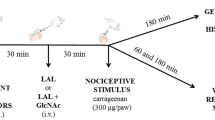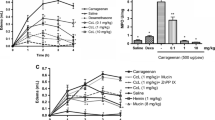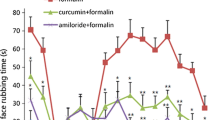Abstract
Objective and design
Sodium channels are highly expressed in nociceptive sensory neurons during hypernociceptive conditions. Based on the presence of a glycosidic portion in the sodium channel β subunit associated to the antinociceptive effect of leguminous lectins via lectin domain, this study investigated the antinociceptive activity of the lectin isolated from Lonchocarpus araripensis seeds (LAL) in mice behavioral models and in NaV current in the nociceptor of rat dorsal root ganglion (DRG).
Material/methods
LAL antinociceptive activity and the participation of opioid system, lectin domain and sodium channels were evaluated in Swiss mice models of nociception (formalin, capsaicin, hot plate, tail flick, von Frey) and in primary cultures of Wistar rats neurons of DRG (patch clamp).
Results
LAL presented inhibitory effects in the nociception induced by chemical and mechanical, but not by thermal stimuli and reduced total Na+ current. LAL activity was inhibited by the lectin association with its binding sugar N-acethyl-glucosamine.
Conclusion
LAL inhibits peripheral hypernociception by mechanisms that involve the lectin domain, inflammatory mediators and Na+ channels. The innovative inhibitory action of leguminous lectins on NaV current brings new insights for the investigation of sodium channels role in nociception.



Similar content being viewed by others
References
Millan MJ. The induction of pain: an integrative review. Prog Neurobiol. 1999;57:1–164.
Aley KO, Messing RO, Mochly-Rosen D, Levine JD. Chronic hypersensitivity for inflammatory nociceptor sensitization mediated by the epsilon isozyme of protein kinase C. J Neurosci. 2000;15:4080–5.
Souza AL, Moreira FA, Almeida KR, Bertollo CM, Costa KA, Coelho MM. In vivo evidence for a role of protein kinase C in peripheral nociceptive processing. Br J Pharmacol. 2002;135:239–47.
England JD, Gamboni F, Ferguson MA, Levinson SR. Sodium channels accumulate at the tips of injured axons. Muscle Nerv. 1994;17:593–8.
Matzner O, Devor M. Hyperexcitability at sites of nerve injury depends on voltage-sensitive Na+ channels. J Neurophysiol. 1994;72:349–59.
Patton DE, Isom LL, Catterall WA, Goldin AL. The adult rat brain beta 1 subunit modifies activation and inactivation gating of multiple sodium channel alpha subunits. J Biol Chem. 1994;269:17649–55.
Isom LL. Beta subunits: players in neuronal hyperexcitability? Novartis Found Symp. 2002;241:124–38.
Sharon N, Lis H. Lectins–proteins with a sweet tooth: functions in cell recognition. Essays Biochem. 1995;30:59–75.
Holanda FR, Coelho-de-Souza AN, Assreuy AM, Leal-Cardoso JH, Pires AF, Nascimento KS, Cavada BS, Santos CF. Antinociceptive activity of lectins from Diocleinae seeds on acetic acid-induced writhing test in mice. Protein Pept Lett. 2009;16:1088–92.
Pinto NV, Santos CF, Cavada BS, do Nascimento KS, Pereira Junior FN, Pires AF, Assreuy AM. Homologous Canavalia lectins elicit different patterns of antinociceptive responses. Nat Prod Commun. 2013;8:1621–4.
de Freitas Pires A, Assreuy AM, Lopes EA, Celedônio NR, Soares CE, Rodrigues NV, Sousa PL, Benevides RG, Nagano CS, Cavada BS, Leal-Cardoso JH, Coelho-De-Souza AN, Santos CF. Opioid-like antinociceptive effects of oral administration of a lectin purified from the seeds of Canavalia brasiliensis. Fund Clin Pharmacol. 2013;27:201–9.
Napimoga MH, Cavada BS, Alencar NM, Mota ML, Bittencourt FS, Alves-Filho JC, Grespan R, Gonçalves RB, Clemente Napimoga JT, Parada CA, Ferreira SH, Cunha FQ. Lonchocarpus sericeus lectin decreases leukocyte migration and mechanical hypernociception by inhibiting cytokine and chemokines production. Int Immunopharmacol. 2007;7:824–35.
Pires AF, Rodrigues NV, Soares PM, Ribeiro RA, Aragao KS, Marinho MM, Silva MT, Cavada BS, Assreuy AM. A novel N-acetyl-glucosamine lectin of Lonchocarpus araripensis attenuates acute cellular inflammation in mice. Inflamm Res. 2016;65:43–52.
Sakurada T, Katsumata K, Tan-No K, Sakurada S, Kisara K. The capsaicin test in mice for evaluating tachykinin antagonists in the spinal cord. Neuropharmacology. 1992;31:1279–85.
Hunskaar S, Role K. The formalin test in mice: dissociation between inflammatory and non-inflammatory pain. Pain. 1987;30:103–14.
Vaz ZR, Cechinel Filho V, Yunes RA, Calixto JB. Antinociceptive action of 2-(4-bromobenzoyl)-3-methyl-4,6-dimethoxy benzofuran, a novel xanthoxyline derivative on chemical and thermal models of nociception in mice. J Pharmacol Exp Ther. 1996;278:304–12.
Eddy NB, Leimbach D. Synthetic analgesics. II. dithienylbutenyl and dithienylbutylamines. J Pharmacol Exper Ther. 1953;107:385–93.
D’amour FE, Smith DL. A method for determining loss of pain sensation. J Pharmacol Exp Ther. 1941;72:74–9.
Cunha TM, Verri WA Jr, Vivancos GG, Moreira IF, Reis S, Parada CA, Cunha FQ, Ferreira SH. An electronic pressure-meter nociception paw test for mice. Braz J Med Biol Res. 2004;37:401–7.
Dunham NW, Miya TS. A note on a simple apparatus for detecting neurological deficits in rats and mice. J Am Pharm Assoc Am Pharm Assoc. 1957;19(46):208–9.
Capaz FR, Vasconcellos LE, De Moraes S, Neto JP. The open field: a simple method to show ethanol withdrawal symptoms. Arch Int Pharmacodyn Ther. 1981;251:228–36.
Joca HC, Cruz-Mendes Y, Oliveira-Abreu K, Maia-Joca RP, Barbosa R, Lemos TL, Lacerda Beirão PS, Leal-Cardoso JH. Carvacrol decreases neuronal excitability by inhibition of voltage-gated sodium channels. J Nat Prod. 2012;75:1511–7.
Leal-Cardoso JH, da Silva-Alves KS, Ferreira-da-Silva FW, dos Santos-Nascimento T, Joca HC, de Macedo FH, de Albuquerque-Neto PM, Magalhães PJ, Lahlou S, Cruz JS, Barbosa R. Linalool blocks excitability in peripheral nerves and voltage-dependent Na+ current in dissociated dorsal root ganglia neurons. Eur J Pharmacol. 2010;645:86–93.
Elliott AA, Elliott JR. Characterization of TTX-sensitive and TTX-resistant sodium currents in small cells from adult rat dorsal root ganglia. J Physiol. 1993;463:39–56.
Figueiredo JG, da Silveira Bitencourt F, Beserra IG, Teixeira CS, Luz PB, Bezerra EH, Mota MR, Assreuy AM, De Queiroz Cunha F, Cavada BS, De Alencar NM. Antinociceptive activity and toxicology of the lectin from Canavalia boliviana seeds in mice. N-S Arch Pharmacol. 2009;380:407–14.
Delatorre P, Rocha BA, Simões RC, Pereira-Júnior FN, Silva HC, Bezerra EH, Bezerra MJ, Marinho ES, Gadelha CA, Santi-Gadelha T, Farias DL, Assreuy AM, Marques-Domingos GF, Nagano CS, Cavada BS. Mass spectrometry and X-ray diffraction analysis of two crystal types of Dioclea virgata lectin: an antinociceptive protein candidate to structure/function analysis. Appl Biochem Biotech. 2011;164:741–54.
Cunha TM, Verri WA Jr, Silva JS, Poole S, Cunha FQ, Ferreira SH. A cascade of cytokines mediates mechanical inflammatory hypernociception in mice. Proc Natl Acad Sci. 2005;102:1755–60.
Alencar NMN, Teixeira EH, Assreuy AMS, Cavada BS, Flores CA, Ribeiro RA. Leguminous lectins as tools for studying the role of sugar residues in leukocyte recruitment. Mediat Inflamm. 1999;8:107–13.
Tj∅lsen A, Hole K. Animal models of analgesia. In: Besson MJ, Deckeson A, editors. The pharmacology of pain. Heidelberg: Springer; 1997. p. 21–41.
Rush AM, Cummins TR, Waxman SG. Multiple sodium channels and their roles in electrogenesis within dorsal root ganglion neurons. J Physiol. 2007;579:1–14.
Scroggs RS, Fox AP. Multiple Ca+2 currents elicited by action potential waveforms in acutely isolated adult rat dorsal root ganglion neurons. J Neurosci. 1992;12:1789–801.
dos Santos-Nascimento T, Veras KM, Cruz JS, Leal-Cardoso JH. Inhibitory effect of Terpinen-4-ol on voltage-dependent potassium currents in rat small sensory neurons. J Nat Prod. 2015;78(2):173–80.
Ferreira-da-Silva FW, da Silva-Alves KS, Alves-Fernandes TA, Coelho-de-Souza AN, Leal-Cardoso JH. Effects of 1,8-cineole on Na(+) currents of dissociated superior cervical ganglia neurons. Neurosci Lett. 2015;595:45–9.
Acknowledgments
The authors thank Conselho Nacional de Desenvolvimento Científico e Tecnológico-CNPq, Fundação Cearense de Amparo a Pesquisa-FUNCAP and Coordenação de Aperfeiçoamento de Pessoal de Nível Superior-CAPES. Leal-Cardoso JH, Cavada BS and Assreuy AM are senior investigators of CNPq.
Author information
Authors and Affiliations
Corresponding author
Additional information
Responsible Editor: Ji Zhang.
Rights and permissions
About this article
Cite this article
Amorim, R.M.F., Pires, A.F., dos Santos-Nascimento, T. et al. The leguminous lectin of Lonchocarpus araripensis promotes antinociception via mechanisms that include neuronal inhibition of Na+ currents. Inflamm. Res. 65, 701–708 (2016). https://doi.org/10.1007/s00011-016-0951-0
Received:
Revised:
Accepted:
Published:
Issue Date:
DOI: https://doi.org/10.1007/s00011-016-0951-0




